Overview
The Golden Brickyard House is a project that is a small part in the restoration of the historic Brickyard House in Golden. Built in the early 20th century, the Brickyard House was built to showcase the multiple brick types produced by Golden Pressed & Fire Brickworks. Since its construction, it has been used for many purposes, ranging from a family home, to an office building, to a house for night watchmen, and even as a shelter for horses. Recently, the Golden Landmarks Association (GLA) has restored the exterior of the building, with the next phase in this restoration process focused on achieving a net-zero energy consumption through the use of solar panels, while also contributing to the City of Golden’s goal to achieve 100% renewable energy for electricity by 2030. This project aims to maximize the solar energy output of the Brickyard House while complying with mandates from the GLA, City of Golden, and Excel.
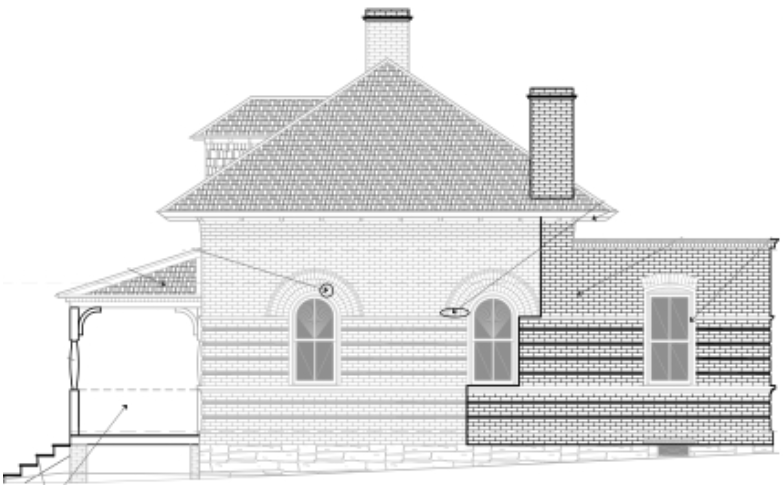
Live Zoom Chat
Use the link below to join us live from 8:00 – 10:30 a.m. on December 3.
Please use passcode: 187870
Or iPhone one-tap: 12532158782,95463616680# or 3462487799,95463616680#
Or Telephone:
Dial: +1 253 215 8782 (US Toll) or +1 346 248 7799 (US Toll)
Meeting ID: 954 6361 6680
Golden Brickyard House
Team Members
- Christian Bagnati
- Hannah Rowan
- Nathan Collins
- Olivia Geesen
The Client
- City of Golden
Acknowledgements
Project Advisor: Prof. Leslie Light
Technical Advisor: Prof. Leslie Light
Video
Elevator Pitch
The Golden Brickyard House senior design project is a team of 4 students working with the City of Golden and the Golden Landmarks association to improve the Brickyard House. The goal is to create a solar array that allows the Brickyard House to run with net zero emissions by using a solar panel array. Through extensive research and consulting with various engineers and stakeholders, the team has developed two design plans for the solar array. The first design is an array that will cover just the energy use of the Brickyard House, while the other is designed to produce enough electricity to meet 95% of the electricity needs of all historic landmarks in Golden combine. These design plans have been presented to the Golden Sustainability Council for further consideration. When completed, this project will stand as a demonstration of how even historic landmarks can be updated to maintain net zero emissions and contribute towards the City of Golden’s goal of 100% renewable energy for electricity by 2030.
Design Approach
The first step in the design process was to analyze the energy use of the Brickyard House. Due to the lack of use of the Brickyard House, there is not reliable energy use data to analyze, therefore, an energy estimate was determined by assuming it would be used in the future as an office building. Data from the U.S. Energy Information Association was the primary source used for this estimate.
Next, the topography of our site was used to determine the area able to be developed for a solar panel array. One of the most important design restraints throughout this project is that the solar array must not be visible from inside of the Brickyard House or from the porch outside, limiting the area for solar panel placement to the south-facing slope of the retention pond behind the Brickyard House, as shown in Figure 1. While this area is large, it is limited by three very important constraints: 1) high-water mark of the retention pond, 2) visibility from the porch of the Brickyard House, and 3) the curved sides of the retention pond.
Based on these criteria, the team moved forward with possible solutions in mind: 1) a solar array to power solely the Brickyard House, or 2) a solar garden design to power additional buildings as well as the Brickyard House. The solar panels and inverters were selected mainly based on efficiency, power output, physical size, cost, availability, and compatibility with both each other and the racking system. With all the materials selected and all the constraints determined, the team moved forward in designing a solution for the Brickyard House and for a larger solar garden.
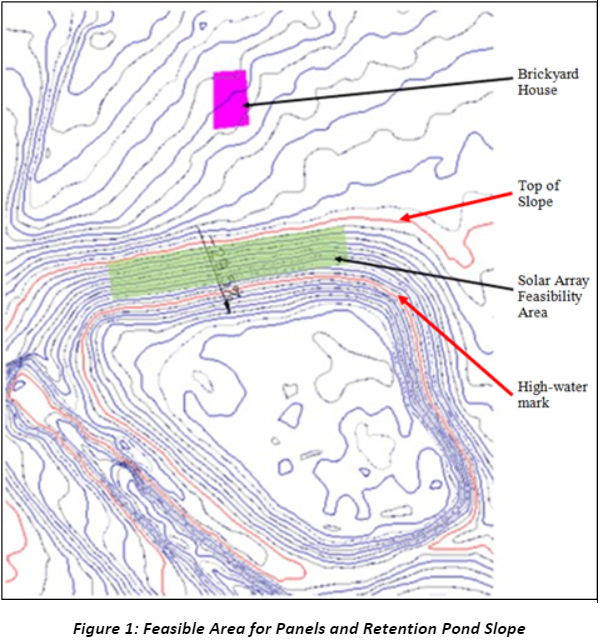
Design Solution
Overall Solution: The racking solution chosen for the design proposals is provided by IronRidge. This solution was chosen due to its configuration flexibility, its ability to comply with all building codes and its ability to be used on a 20° slope. While the optimal tilt and orientation for the solar array is a 35° tilt face 180° (true south), a design with a slope of 20° and an orientation of 171° was used for both the Brickyard House and solar garden designs. One of the main factors for choosing a 20° was for visibility reasons. Since the slope of the retention pond is also 20°, this tilt allows the design to use the most amount of available area without the panels being visible from the Brickyard house. By using an orientation of 171°, this design avoids expensive grading since the slope of the retention pond is oriented at 171°. The cost and space savings provided by using a non-ideal angle and orientation far outweigh the loss of less than 5% of power production, making this the ideal design choice. The panel and inverter chosen for both designs are the Fronius Symo 17.5 and the REC Alpha 365W, respectively. Both the panel and inverter were chosen for having the overall best performance with regards to the previously mentioned factors.
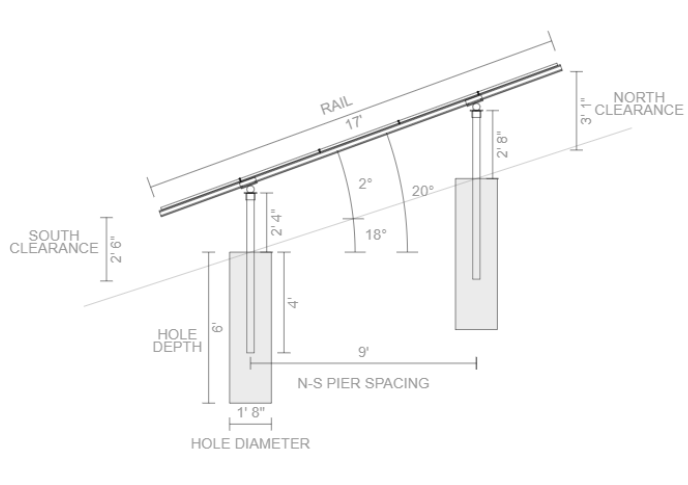
Brickyard House Design: Xcel Energy restrictions limit the amount of energy produced by a solar array to 120% of the maximum projected energy use of a given building. Given this restriction, the upper limit on energy production for this design is 33,000 kWh. A racking configuration of 3 panels high in landscape orientation was used, limiting the maximum output to 32,300 kWh using 54 panels and 1 inverter, with a layout as shown below. The total cost of this design is $63,700 with a payback period of 16.6 years.
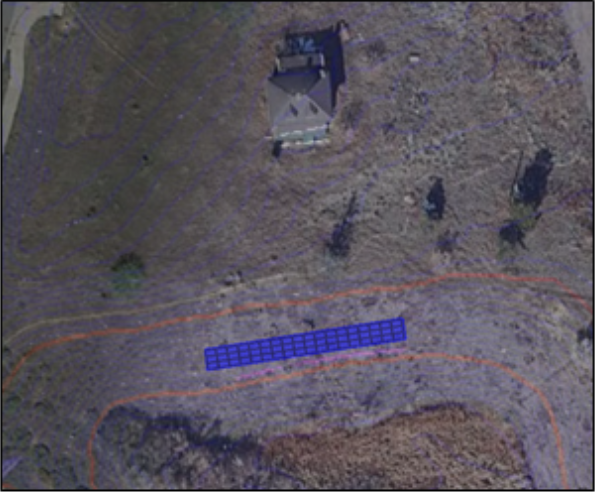
Solar Garden Design:Unlike the Brickyard House design, the solar garden design was not limited by Xcel regulation, but rather the space available on the retention pond slope. The panels are racked in a 5 high configuration on landscape orientation. The down side to this design is that the panels are visible by 11 inches. To solve this problem, native plants are recommended to be planted on the top of the slope in order to block the view of the panels. The estimated power output for this design is 120,500 kWh using 200 panels and 4 inverters with a layout as shown below. This produces enough energy to meet 95% of the energy demands from all of the historic buildings in Golden. The cost is $199,700 with a payback period of 10.2 years.
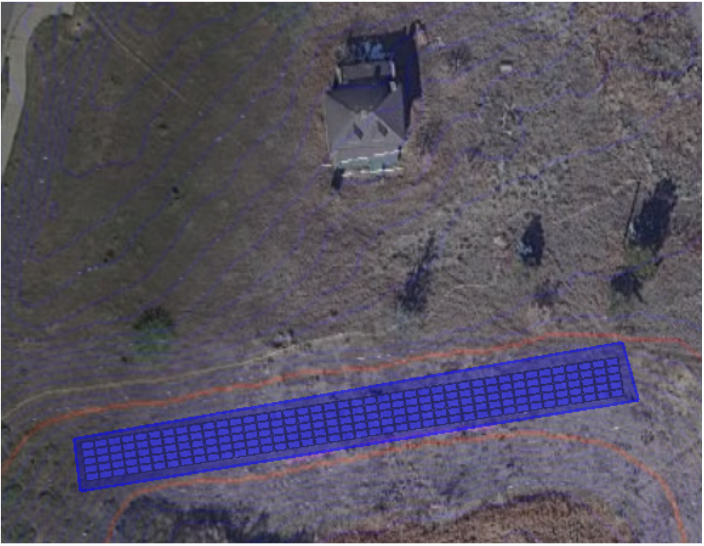
Next Steps
The next step for continuation in this project is to secure funding for updating and restoring the Brickyard House. Once the Brickyard House is usable as a community center or office building, the energy use estimate should be updated considering the known future use of the building as well as the installed appliances and heating/cooling until. The decision must also be made on whether the array will be for the Brickyard House or used as a solar garden, in which case subscribers will need to be found in order to reach the minimum limit of 10 subscribers set by Xcel Energy. Finally research should be conducted for how funding will be secured for the installation of the solar array.
Meet the Team
Christian Bagnati
Born in California and rasied in New Jersey, I can’t get enough of the shore. When it comes to engineering, it all intrigues me, so I moved to Colorado to become an engineer. As a bonus I got to experience the mountains and instantly started enjoying all things outdoors, from snowboarding and skiing to biking and rock climbing.